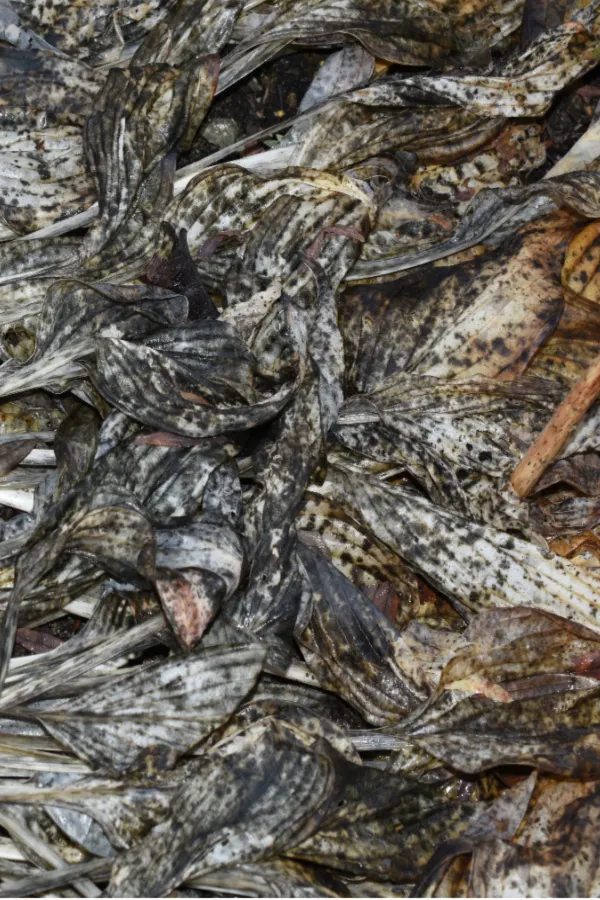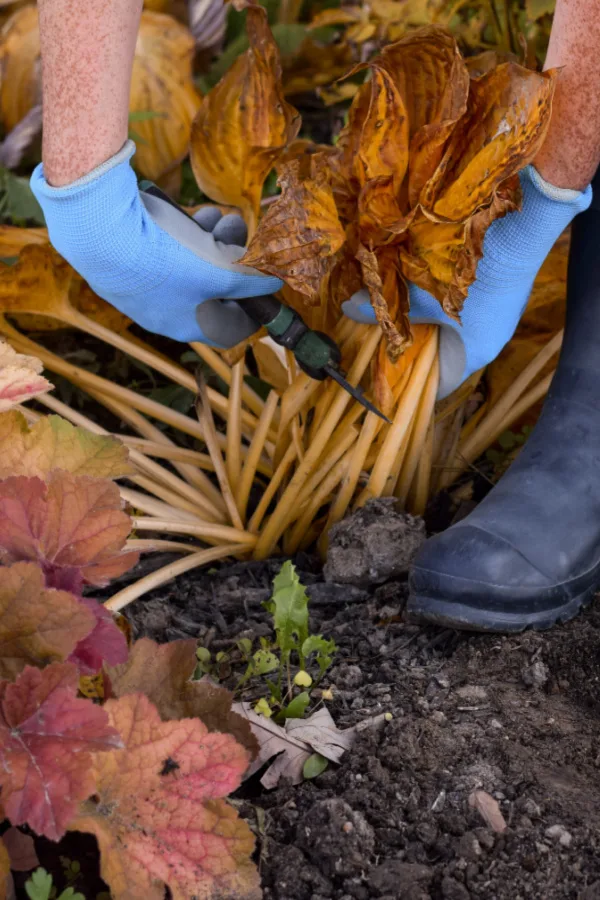Wondering what you need to do before winter arrives with all of those hostas browning off and dying back in your flowerbeds? Or if you need to do anything to them at all?
Hostas are a popular mainstay in flowerbeds and landscapes in a wide array of regions throughout the world. The shade loving plant adapts well to nearly any soil and climate, surviving in growing zones as cold as three and as warm as nine.
But as mid to late fall arrives, no matter where you happen to grow this beautiful big-leafed plant, its foliage begins to finally die back before the arrival of winter. And when it does, it’s time to perform a few simple but critical chores to help it stay healthy.

One thing is for sure, all of a hostas decaying leaves can certainly be anything but attractive in late fall. But is it okay to cut them back? Do they need that foliage for winter protection? And should they be fertilized or mulched before the snow starts flying?
All of the above are certainly great questions. And believe it or not, what you do with your hostas before winter can play a huge role in not just how well they survive winter, but also in how they perform next spring and summer.
What To Do With Your Hostas Before Winter
The good news is that preparing your hostas for winter is quick and simple! In fact, hostas happen to be one of the easiest of all perennial plants to prepare for the off season. And that simple care all begins with cutting their dying foliage back in late fall.
Why To Cut Back Hostas Before Winter
When it comes to all of that unsightly decaying foliage, it’s far better to remove all the leaves before winter arrives than to let they stay until spring. Not only will it tidy up your flowerbeds, it can also help in keeping your hostas healthy and disease free.
Allowing all of a hosta’s dying foliage to remain all winter long can cause issues. Both for your hostas, and for the soil and plant around them. That is actually the case with most herbaceous perennial plants. See: How To Protect Perennial Plants For Winter

For starters, as the leaves die back, they become a magnet for pest and insects to take up residence. Not only does the spent foliage provide them a source of food, it also provides them cover. And because it often stay wet and moist in the cool, fall air, it gives them plenty of moisture as well.
Those three combinations are exactly what pests need to survive and thrive. With food, water and cover, they can breed at will. And even if the insects die off during the cold of winter, the eggs they leave behind are ready to hatch next year to continue dining on your plants.
In addition to attracting pests, dying foliage is also a breeding ground for mold, mildew and other disease. Again, like pests, if left to multiply, it can overwinter and come back to infect otherwise healthy plants – including your hostas!
Cutting Back The Foliage – What To Do With Hostas Before Winter
Cutting back your hostas in late fall couldn’t be easier. Using a pair of garden scissors or hedge trimmers, simply slide the blades under the limp foliage and shear it off. It’s best when doing so to leave a few inches of stems above the soil line. This will help you know exactly where plants are when mulching – and early next spring when planting other plants around them.

Don’t just toss the spent foliage away. The cuttings from hostas are actually excellent to add to your compost pile. Not only do they decay quickly, they also add a fair amount of nutrients as they break down.
Once your plants have been cut back, it’s time to protect the base with mulch. Like many hardy perennials that overwinter, it’s not the act of freezing that can kill the roots and the plant, but instead, when the roots rapidly freeze and thaw over and over.
Mulching Your Plants – What To Do With Hostas Before Winter
Once your plants are cut back, the one final task that needs to be performed is to mulch your hosta crowns before winter arrives. Fall mulching of flowerbeds in one of the most underrated and under-performed chores of all – and it can be especially helpful for hostas.
For starters, a three to four inch layer of mulch over the top of your hostas helps provide winter insulation. The roots of hostas can handle freezing. But where they can incur damage is when the soil constantly thaws and freezes. And without mulch, that is exactly what happens.

When plants are properly mulched, it keeps the soil temperature more evenly regulated. And without wild swings in temperature, the plant’s roots can slowly freeze and thaw, keeping them safe from injury in the process.
Beyond protecting the root structure of your hostas, mulching also helps keep moisture in and weeds out. Moisture is important for the roots to keep them healthy and alive. And by preventing weed seeds from finding a home, you can significantly decrease next year’s weeding chores in the process.
Shredded hardwood, shredded bark, straw or shredded leaves all make great winter mulch for hostas. Simply pile it on and around the crowns of the plants to a depth of three to four inches.
Fertilizing – What To Do With Hostas Before Winter
One thing you do not want to give your hostas in late fall is fertilizer. Fertilizing any perennial plants late in the year can actually cause the plants to attempt to grow. As they head into dormancy, this can put the plant at a much higher risk of winter damage.
Instead, wait until early in the spring to give your hostas a boost of energy. A basic, all-purpose granular fertilizer applied just as they begin to sprout will do wonders for early growth. Product Affiliate Link: All-Purpose 10-10-10 Granular Fertilizer
Now that your hostas are ready for winter, it’s time to sit back and enjoy a little break from your garden chores. And next year, your hostas will be ready to hit the ground growing!

Follow Our Facebook Page For Great Gardening Tips And Advice! This Is My Garden Facebook Page
This Is My Garden is a garden website created by gardeners, for gardeners. Jim and Mary Competti have been writing gardening, DIY and recipe articles and books and speaking for over 15 years from their 46 acre Ohio farm. They publish three articles every week, 52 weeks a year. Sign up today to follow via email, or follow along!
